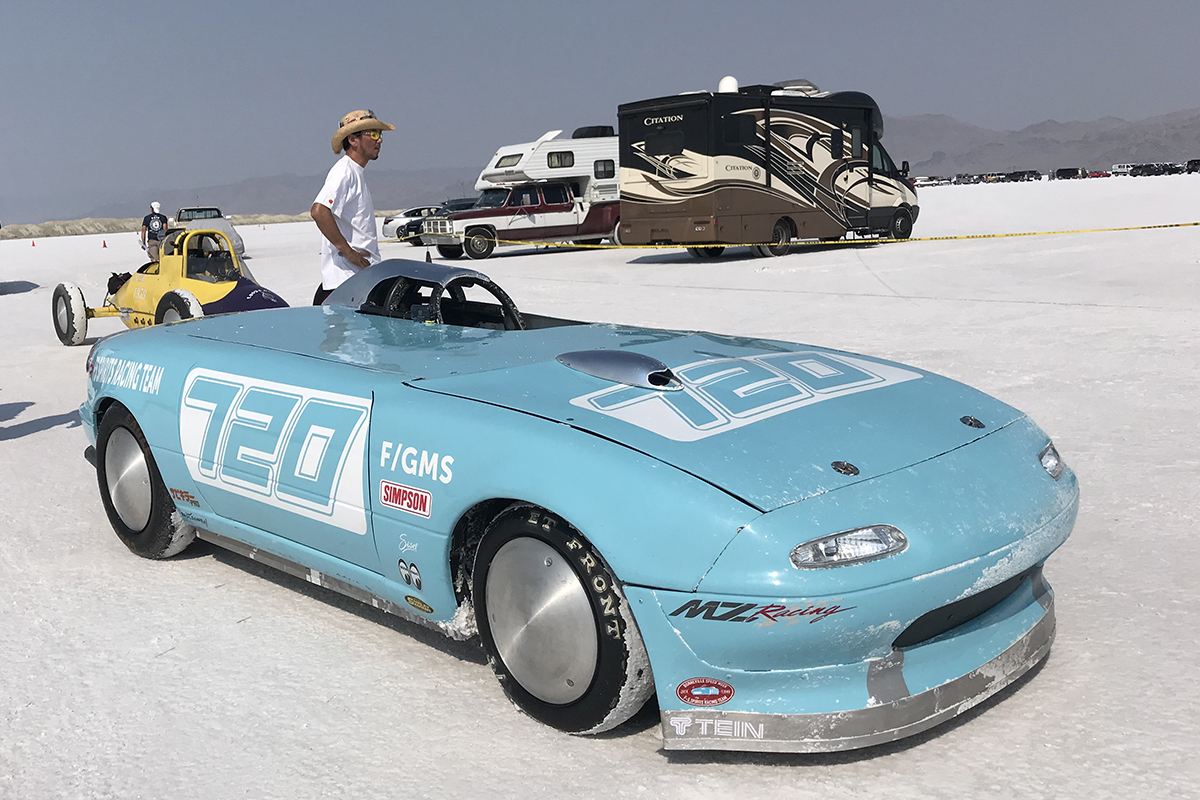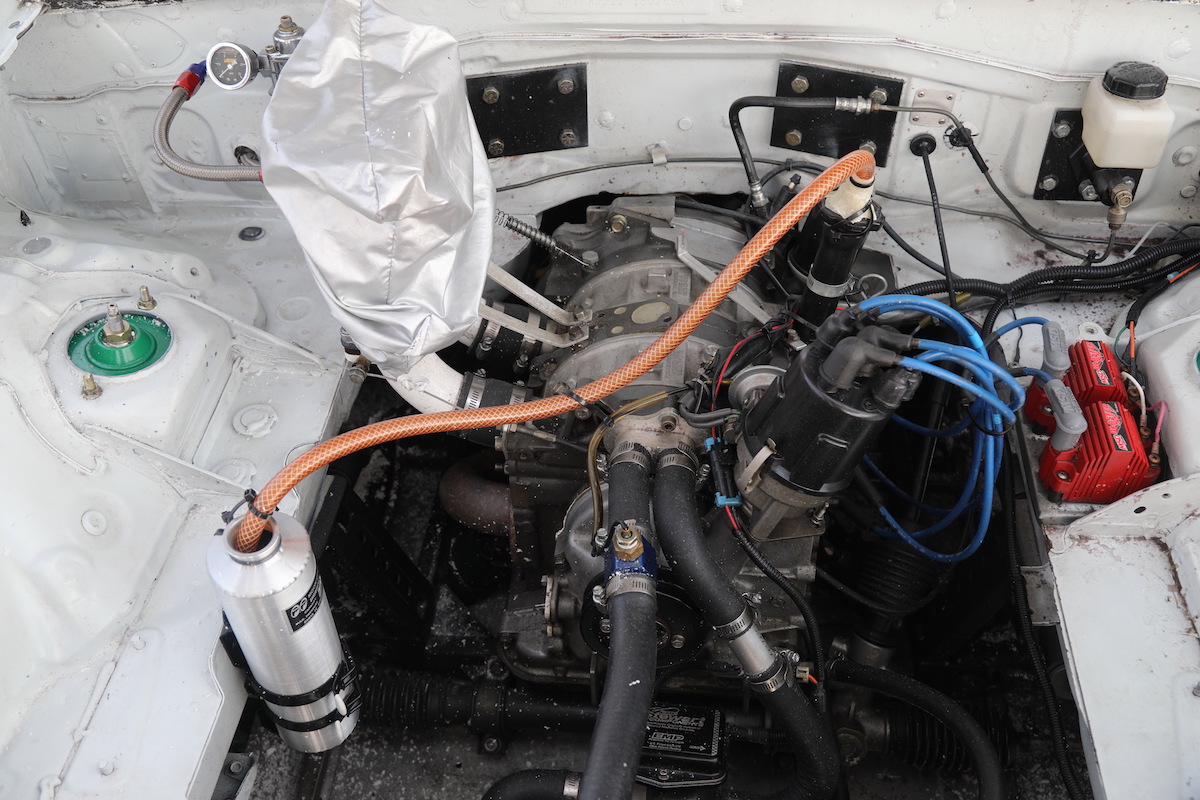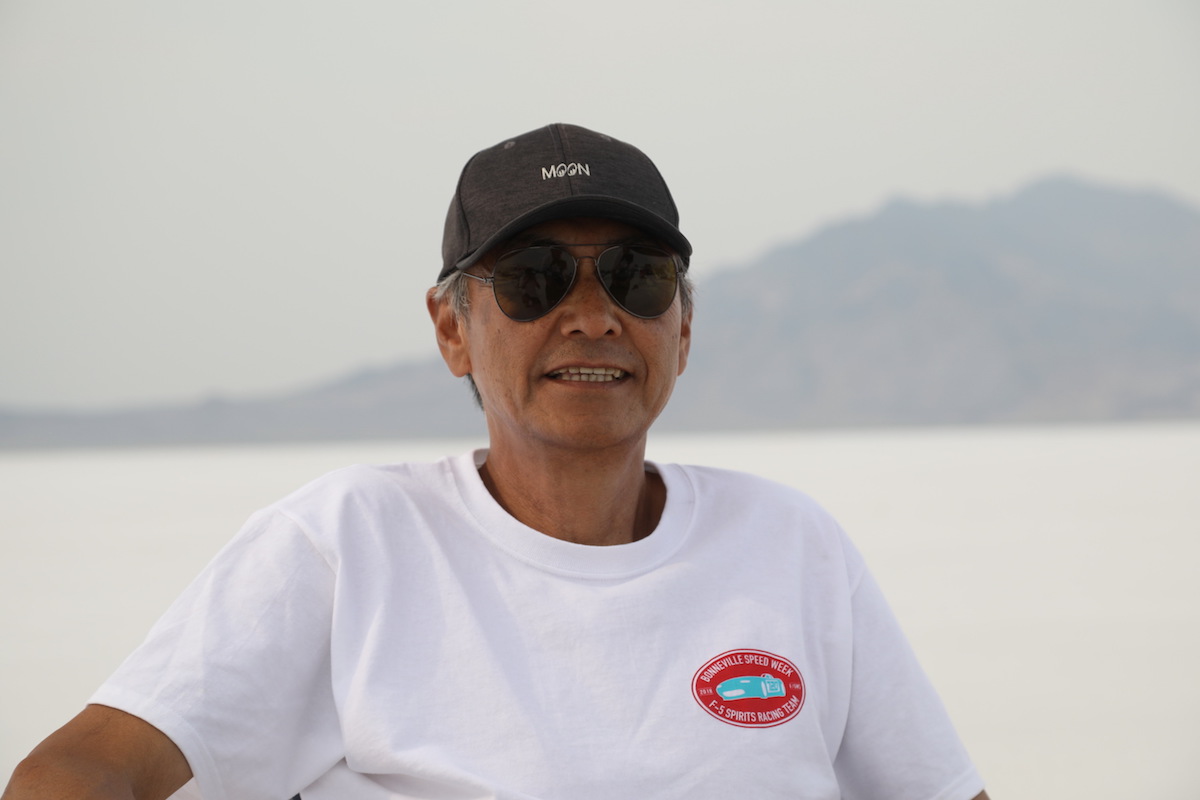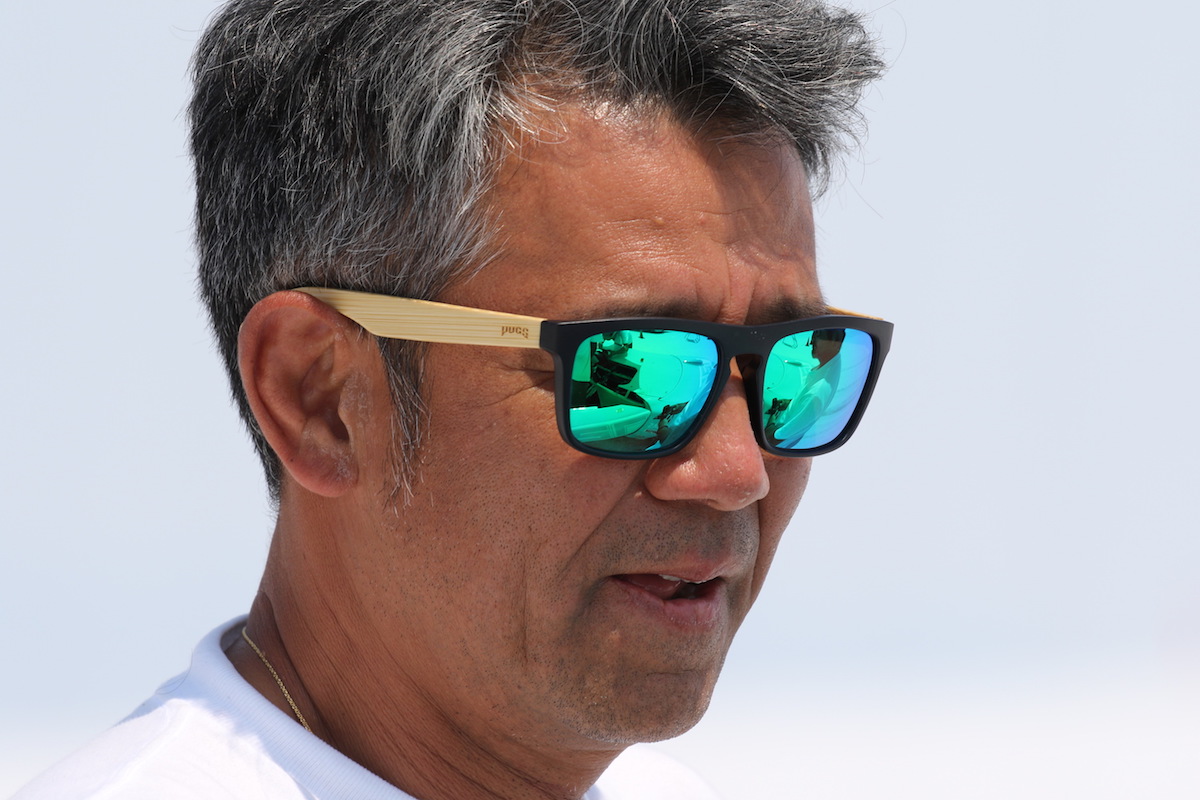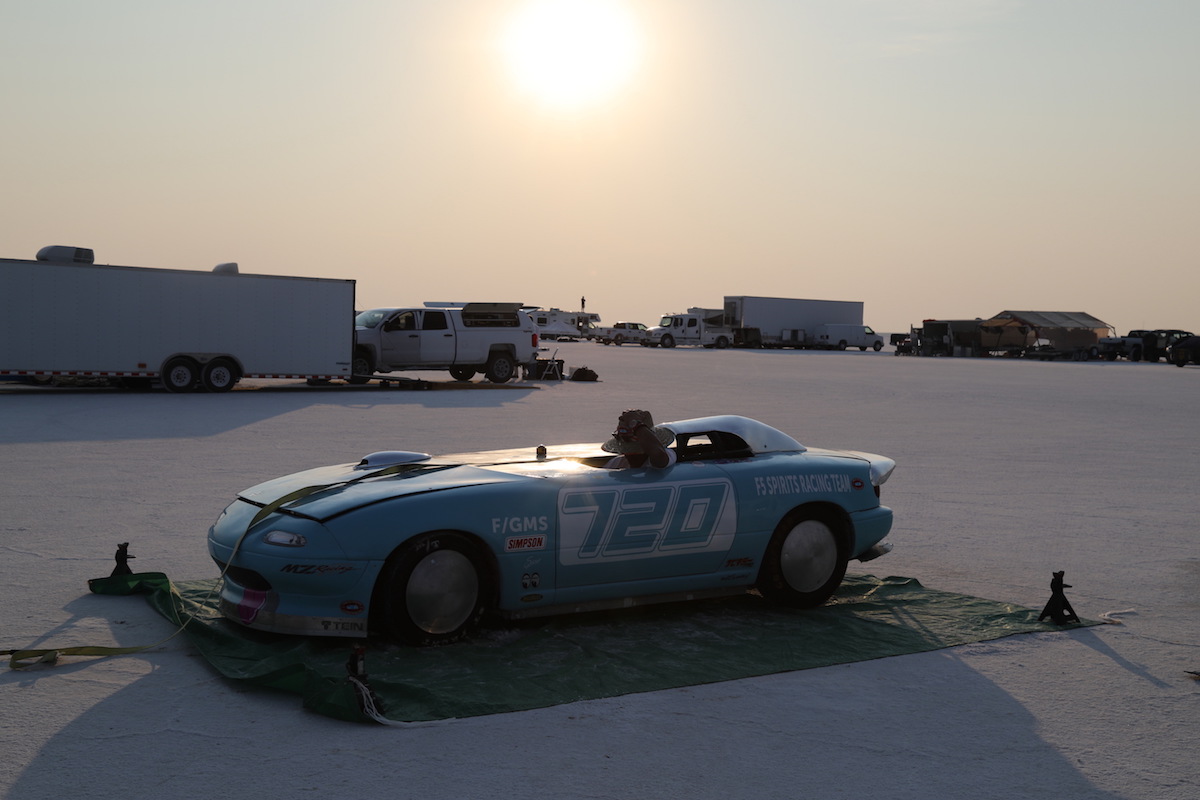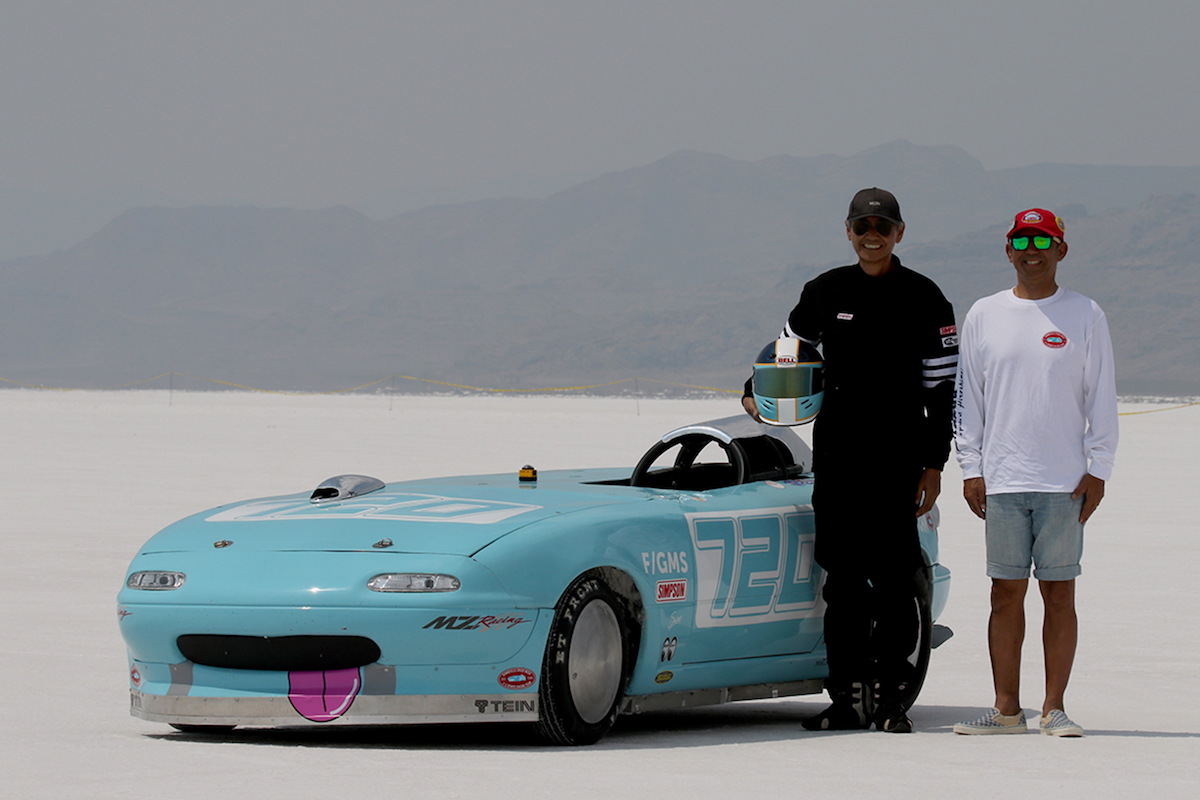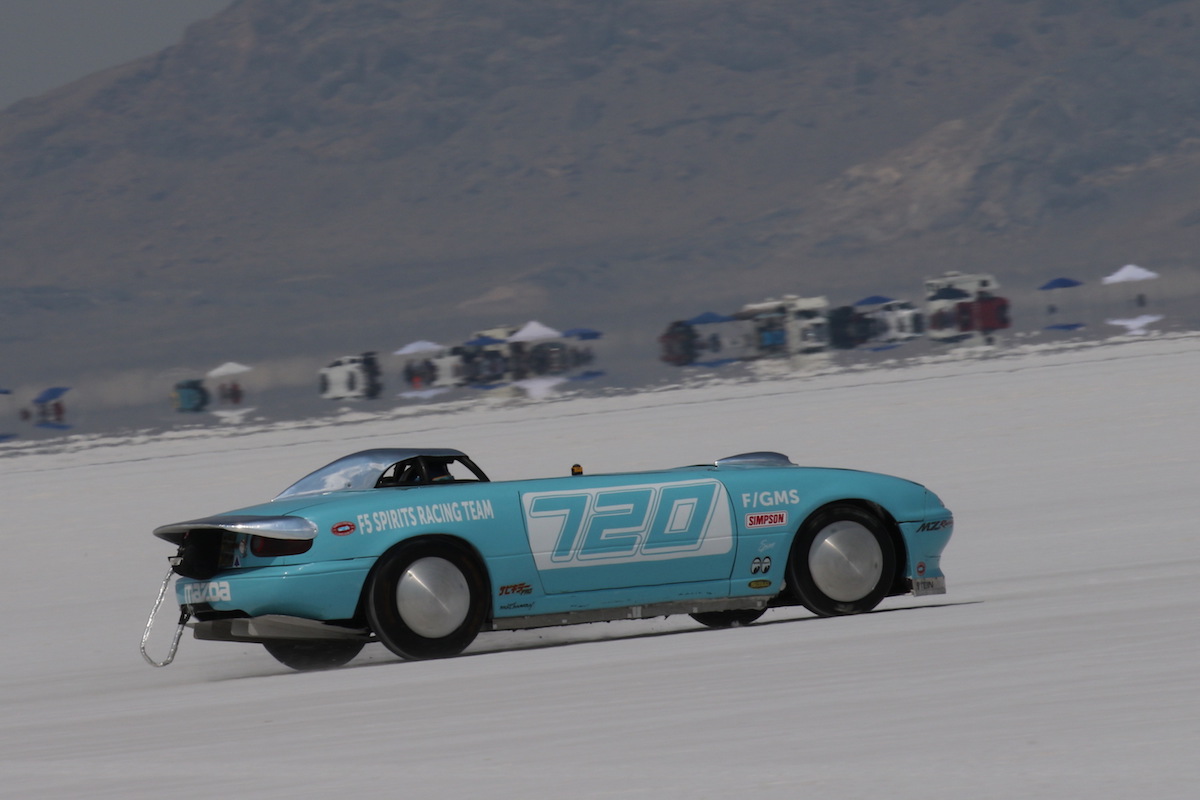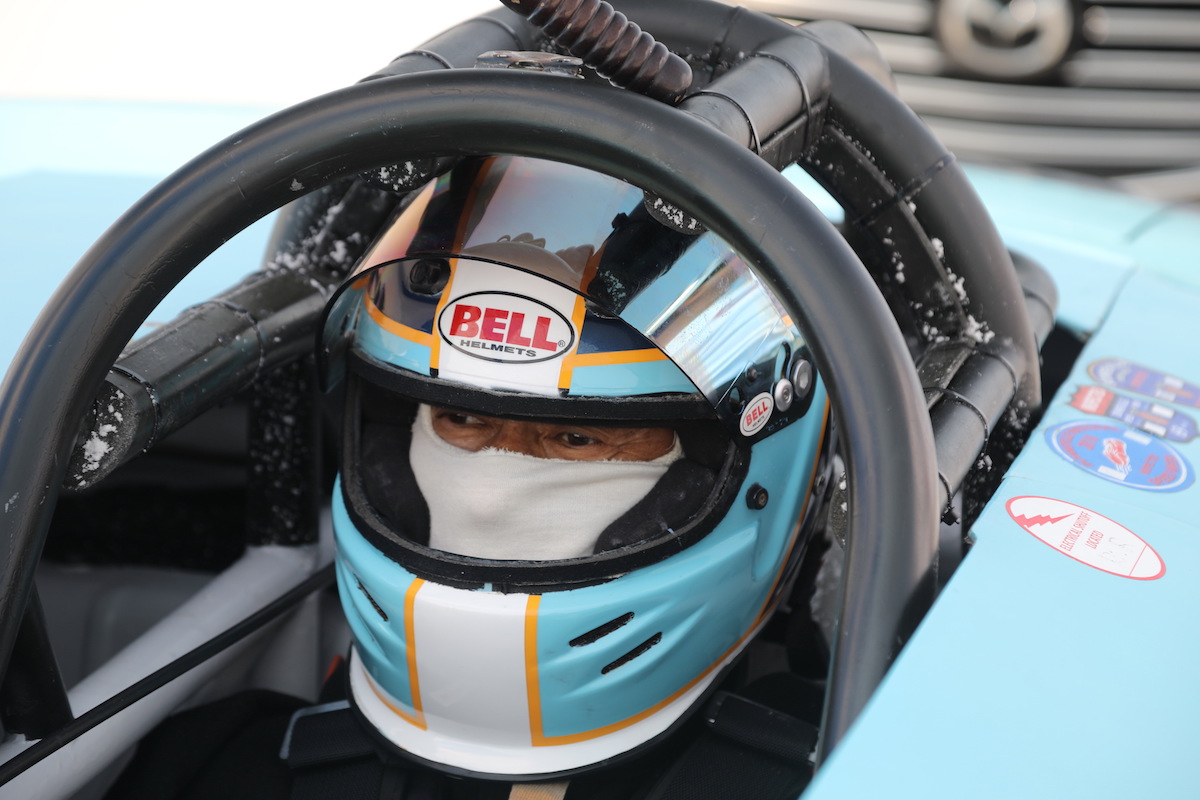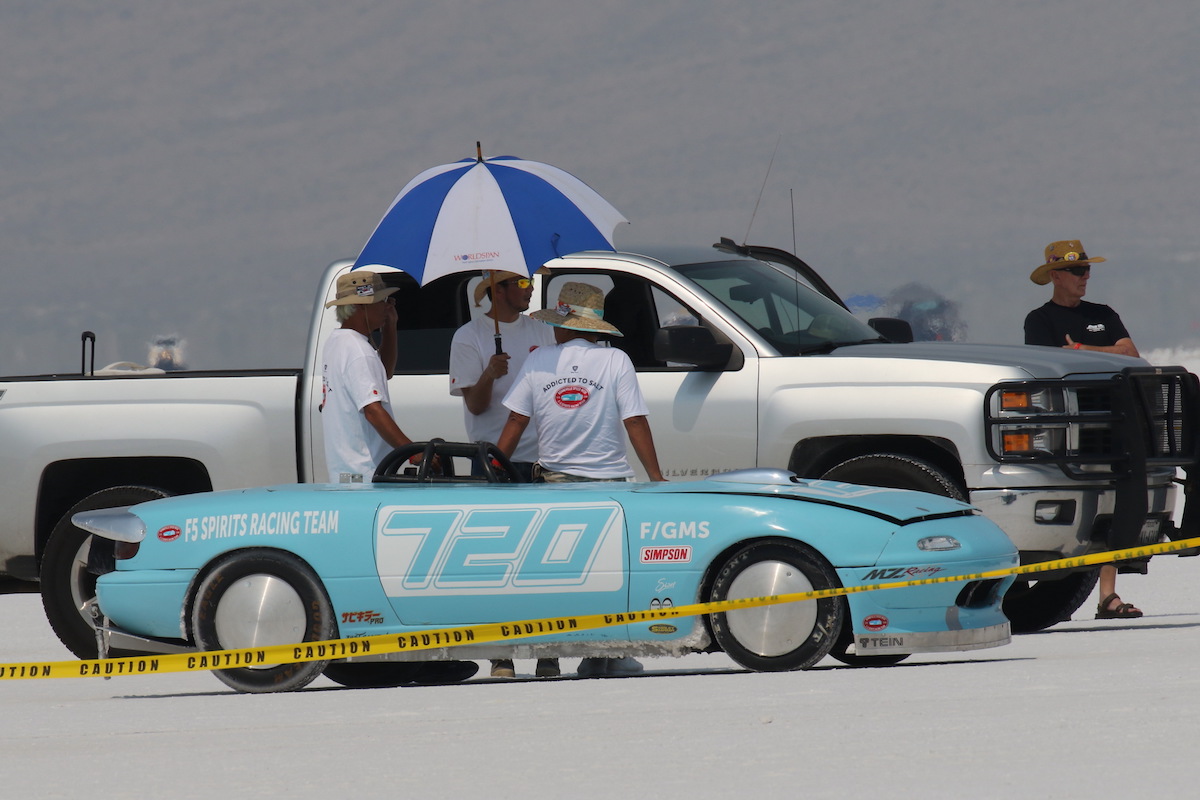- 2018/08/20

#720 RE Miata Records 280km/h at Bonneville
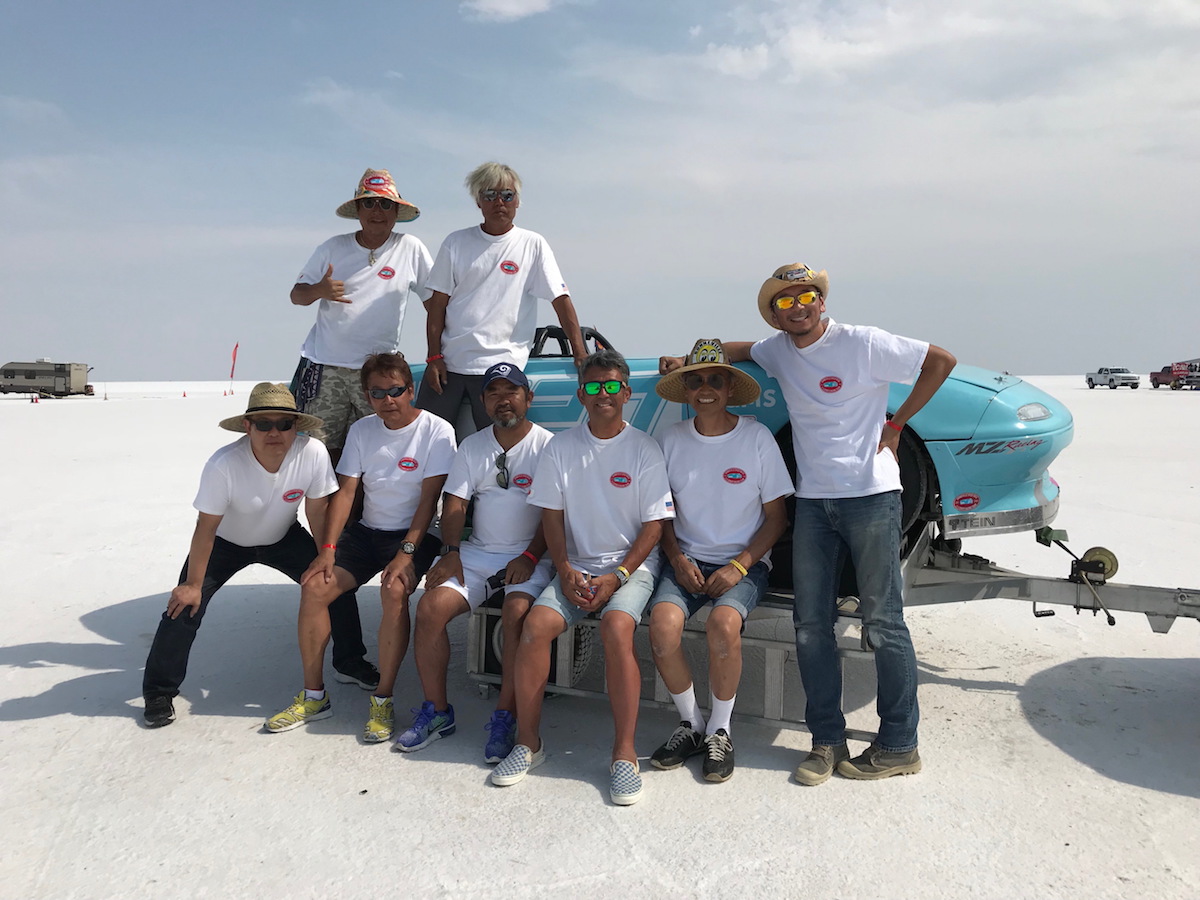
The 70th Bonnneville Speed Week was held at Utah’s Bonneville Salt Flats from August 11th where the F-5 Spirits Racing Team led by Los Angeles resident Sam Okamoto, achieved a personal best land speed of 280km/h, achieving their goal for this year. In this their third challenge they achieved a major first step towards their dream.
The current goal of entertainment producer, Okamoto was to take on the modified market model sportscar category with a 3 liter naturally aspirated NA type Mazda MX-5 mounted with a 13B rotary engine and clear a maximum speed of 280km/h (approx. 175 miles/h). The first time the team intended to take on the challenge was in 2014 but that year, as they headed to the venue, torrential rains poured down on Bonneville Speedway (a location that could fit the entire Yamanote Line) transforming it into a veritable lake and the event was cancelled. In the following year the track conditions weren’t perfect and it was feared that the future of this legendary speed challenge event may be in jeopardy. Halfway through last year it looked possible that the organizers may again give up on the event but as the year moved into early summer the Southern California Timing Association (SCTA) announced that the 2016 meet would go ahead and Okamoto hastily made preparations with his team.
After they transported the machine from LA, a trip of about 1000km, their hastily prepared car just barely made it through vehicle inspection. Despite the hastily made prep, they were still able to record a speed of 151mph (241km/h). Having skipped two years the team was becoming somewhat despondent but Okamato’s indomitable spirit was reignited this year. However, in 2017 the conditions at the salt flats weren’t great and in their first run they dropped into a crevice in the connecting road and damaged the machine’s upper arm. Also, this year the crew chief, Yoichi Irie, who had been working on the car right from the beginning, was unable to adjust his schedule to take part and this left the team in a conundrum. Along with that, strong winds assaulted the venue several times and this meant that the team could only run on two of the four days they were scheduled to compete, which meant they couldn’t run as much as they hoped. Due to these issues the fastest time they could record was a 137mph (219km/h), slower than their previous effort. This showed them that they had a lot more work to do in order to raise the car’s performance.
This year Okamoto began working on the car much earlier than in previous years. To begin with, he perfected the belly pan, which conducts the air on the underside of the car’s body, which had been an issue in their previous attempts. He also replaced the WEVER carburetor from a 48 Φ to a 51 Φ in order to increase power. In addition, concentrating on improving aerodynamic performance, he installed a new duck tail spoiler, sealed the front bumper opening, added a forced cooling fan to the radiator and installed an air intake to the bonnet and a canopy roof to the roll cage. In order to increase the power he also enlarged the carburetor and the measured value on the dynamometer was 220hp at 8,000rpm. Okamoto believed that a peripheral port NA 13B would be capable of producing 250hp. With Bonneville being located at an altitude of 1,200 meters, it was certain that their would be a limit on the power the car could produce.
However, this year the team were heading into the event with new determination. This was due to the fact that Hikaru Miyagi, who recorded a 261.966mph (421.594km/h) at Bonneville in 2016 driving a Honda Streamliner, the fastest in the FIA class, would join the team as a guest driver. A former All Japan Grand Prix rider, he is a skilled rider who as taken several championship titles and has also competed on four wheels in the Super Taikyu, amongst other series. Miyagi’s knowledge and high speed techniques were certain to contribute to the team’s efforts.
This year’s Speed Week began on the morning of August 11th with a driver’s meeting. After that there was one high speed trial. For this, team owner, Okamoto took the wheel. On the 2-mile rookie course, the shortest of the venue, he recorded the same as last year’s best, a 157mph (252km/h). Going onto the 3-mile course, Okamoto implemented two runs and marked down a 161mph (259km/h). From then Miyagi took the cockpit. Under a temperature of 33°C, the conditions of the salt flats were good and the whole team was eager to see what Miyagi could do. He went on to record a 163mph (262km/h).
Waiting for pick up at the finish point, Miyagi stated, “The straight away speed is pretty good. The car feels great to drive.” While the team was elated that the car was getting faster with each run, a problem arose. According to Miyagi, “In the middle of the run it felt like there was a little overheating and we might be leaking some engine oil.” Opening the engine hood it was revealed that the join of oil filter tower had come loose and a large amount of oil was spraying into the engine room. After returning to the pit they found that the amount of oil lost was not too excessive and it was unlikely that it had damaged the inside of the engine so the team was slightly relieved. They decided to replace the oil catch tank and began carrying out work.
Miyagi then suggested they increase the air-fuel ratio and so they increased the main jet another two levels. The team next used the second day’s trials to confirm the carburetor’s setup in two runs but there wasn’t an explicit increase in performance or increased speed. Not only that, this time the cooling water boiled over and overflowed. They made the decision to head into the next trial after they had adequately cooled down the cooling water and so ended their runs for the day. Then on the third day, they closed the front intake, which they had opened thinking it might improve the cooling, and headed into the next attack having reduced air resistance through reducing the amount of air flowing through the engine room. As a result, Miyagi, who took the wheel for the second run, recorded a 173.5mph (279km/h), which put the team into high spirits. The temperature was relatively cool on the fourth day and so the team thought that if they went back out onto their second run quickly they should be able to achieve their goal and the everyone was feeling very positive.
On the final day the team would compete, August 14th, they headed out from their hotel at 6:00am. However, they were not the only team who wanted to make their attempts when conditions were good. As they headed to course 3 following preparations, there were already 20-cars lined up waiting to make their runs. This left them waiting about an hour and a half before their first run of the day, which was the eight of the course. The temperature was 26°C and mostly still, perfect for a speed run. Driver Okamoto was completely focused at the start and in the end recorded a 174.756mph (281.2km/h). The team were ecstatic with this result and felt that all their trials and tribulations up until this point had been rewarded. They all said together, “Our next goal is a class record of 200.24mph (322km/h).
Team representative, Okamato stated, “This result was due to everyone coming together and I’m really satisfied to have been just 0.244mph off our target speed. Thank you so much to all those who have supported us. We’ve found all the areas that we need to work and I want to work to solve all those issues and come out next year to try and record a speed over 200mph.”
[Video Report]
RE Miata’s Bonneville Challenge 2018 (YouTube 5’06”)
Text and Photos by MZRacing
Archive
2024
2023
- 07/10
Mad Mike Breaks Records at Pikes Peak - 05/03
S-Tai Completes Official Testing for 24 Hours of Fuji
2022
2021
- 11/16
Mazda wins 2021 Petit Le Mans in last race for the Mazda RT24-P  10/01
10/01
Tenacity maintains Mazda Motorsports’ third place in the IMSA WeatherTech SportsCar Championship standings 09/22
09/22
Frustrating fifth in Monterey for Multimatic Motorsports 08/16
08/16
Idemitsu No. 55 Mazda Motorsports Mazda DPi Takes Second at Road America 06/30
06/30
Mazda’s DPi Win at Watkins Glen Good to the Last Drop 06/18
06/18
Championship hunt still on for Mazda Motorsports after a bruising race in Detroit 05/21
05/21
Mazda take another podium at Mid-Ohio 03/24
03/24
Mazda RT24-P takes 2nd place in IMSA Sebring 12 Hours 02/01
02/01
Mazda RT24-P Takes Miraculous 3rd at the 24 Hours of Daytona 01/29
01/29
Countdown Begins for 2021 Daytona 24 Hour Race
2020
 11/16
11/16
Mazda RT24-P takes overall victory legendary 12 Hours of Sebring 11/15
11/15
Multimatic enjoys change in fortune with the Mazdas back on upward curve at Laguna Seca 10/23
10/23
Lady Luck dominates Multimatic Motorsports’ Petit Le Mans weekend 10/02
10/02
Mazda RT24-Ps finish 4th and 5th at Mid-Ohio 09/07
09/07
2nd place finish for #55 Mazda RT24-P at Road Atlanta 08/04
08/04
Mazda RT24-Ps grab 5th and 6th at Road America 07/06
07/06
Mazda RT24-P Welcomes Season Return with 1-2 Finish at Daytona 240 01/27
01/27
Mazda Drives To Second Place In Rolex 24 At Daytona 01/26
01/26
Mazda RT24-P earns Daytona pole for second consecutive year 01/09
01/09
Pla and Mazda Qualify First, Set Unofficial Daytona Course Record
2019
 12/10
12/10
Mazda 2 R1 Has Amazing Debut at the FIA NACAM Rally 10/24
10/24
IPS “Jinba Ittai Academy’s” Mushitani grabs first win 10/15
10/15
Mazda Team Joest Just Misses Victory At Petit Le Mans 10/02
10/02
Mazda Unveils Mazda3 TCR 09/20
09/20
After Close S-Tai ST-5 Motegi Race, Demio Takes 2nd and Roadster 3rd 09/20
09/20
Sixth For Mazda In Monterey 09/01
09/01
RE Miata’s 2019 Bonneville effort struggles with loose salt 08/06
08/06
Mazda Scores IMSA Hat Trick 07/08
07/08
Mazda Doubles Down With Second Straight Victory 07/01
07/01
Mazda Dominates In Watkins Glen For Breakthrough IMSA Victory 06/10
06/10
Up and Down Day in Detroit for Mazda 05/09
05/09
Mazdas Battle to Double Podium at Mid-Ohio 04/26
04/26
Okada Demio 15MB Takes 3rd place at JRC round 3 04/16
04/16
Mazda Comes Home Fourth in Long Beach 03/18
03/18
Mazda Team Joest finish 6th and 11th at Sebring 12 hours 01/28
01/28
Two Mazda RT24-Ps retire due to technical trouble 01/28
01/28
Mazda RT24-P grabs pole position
at Daytona 24 official qualifying 01/25
01/25
24 Hours of Daytona Race Week Begins
2018
 10/23
10/23
Double Podium For Mazda At Petit Le Mans 10/09
10/09
Nikko Reger Claims Global Mazda MX-5 Cup Championship 09/14
09/14
Mazda Dominates Before Finishing Fourth At Laguna Seca 08/20
08/20
#720 RE Miata Records 280km/h at Bonneville 08/07
08/07
Mazda Narrowly Misses Victory At Road America 07/24
07/24
Sixth Place in Canada for Mazda Team Joest 07/06
07/06
Mazda Finishes Tenth At Watkins Glen 06/26
06/26
RE Powered MX-5 Miata Set to Once Again Challenge the Bonneville Salt Flats 05/09
05/09
Mazda Scores First Podium of the Season at Mid-Ohio 04/16
04/16
Fighting Fourth At Long Beach For Mazda 03/19
03/19
The Mazda RT24-P Encounters Misfortune With the Podium in Sight 03/17
03/17
Mazda Team Joest Prepared For 12 Hour Challenge Of Sebring 03/16
03/16
Mazda Team Joest Charges To Sebring 01/29
01/29
Mazda Team Joest Have a Rough Start to the IMSA Season 01/27
01/27
The Teams Take It Easy on Friday Ahead of the 24 Hours of Daytona 01/26
01/26
24 Hours of Daytona Schedule Officially Kicks Off
2017
 08/17
08/17
RE Miata Falls Short of Rewriting Bonneville Record 07/12
07/12
Strong Performances See Mazda RT24-Ps Finish in Top 5 07/04
07/04
Mazda Prototype Team Grabs Second Consecutive 3rd Place Podium Finish 06/05
06/05
#70 Mazda RT24-P Grabs 3rd Place at Belle Isle 05/09
05/09
Rough Day at COTA For the Mazda Prototypes 03/20
03/20
Mazda RT24-P Passes Checkered Flag After a Tough 12 Hours of Sebring 02/01
02/01
Mazda RT24-P Falls Short of Checkered Flag at 24 at Daytona 01/28
01/28
On The Cusp of the 55th Rolex 24 At DAYTONA
2016
 10/18
10/18
Mazda Prototype Misses Out on Podium Finish at Petit Le Mans 09/12
09/12
Yui Tsutsumi Takes 3rd Place Podium in Global MX-5 Cup Invitational Race 2 09/12
09/12
Tsutsumi Grabs 8th in Global MX-5 Invitational Race 09/12
09/12
Tsutsumi Secures 5th Place in Global MX-5 Cup Invitational Race Qualifying 09/09
09/09
Mad Mike’s HUMBUL RX-7 Grabs 9th at Formula Drift Okayama Round 07/11
07/11
Mazda Prototype Finishes 5th in Mobil 1 Sportscar Grand Prix at CTMSP 07/10
07/10
Mazda Prototypes Qualify Pole & 3rd at IMSA Sportscar Grand Prix CTMP 07/04
07/04
Mad Mike’s Mazda MX-5 – RADBUL Does Battle in Scorching Hot Orlando Heat 07/04
07/04
Mazda Prototype Finishes in Top 5 at Watkins Glen 07/03
07/03
Mazda Prototypes Qualify 2nd and 3rd 07/01
07/01
Mazda Prototype to Compete in 6 Hours of the Glen Sporting Special Livery 06/05
06/05
Mazda Prototype Grabs First IMSA WeatherTech SportsCar Championship Podium 05/25
05/25
Mad Mike Takes Victory at FD Ebisu in HUMBUL RX-7 05/03
05/03
Mazda Prototypes Just Miss Out on Podium from Front Row Start 05/01
05/01
Global MX-5 Cup Launches at Mazda USA’s Home Course 04/18
04/18
Mazda Prototypes Finish 4th and 5th at Long Beach 03/20
03/20
IMSA 12 Hours of Sebring Day 3 Both Mazda Prototypes Achieve Top 10 Finishes 03/19
03/19
IMSA 12 Hours of Sebring Day 2 Mazda Prototypes Qualify Their Highest Ever, 5th and 7th 03/18
03/18
IMSA 24 Hours of Sebring Practice Sessions Start 03/16
03/16
High Hopes for Success With New “Mazda MZR-2.0T” Engine 03/11
03/11
Mazda Racers Take 3 Class Victories and 8 Podiums 02/01
02/01
Two Mazda Prototypes Leave Fray Before the Sunrise Rolex 24 At DAYTONA 01/30
01/30
Mazda Prototypes Pass Through Torrential Qualifying Session. Rolex 24 At DAYTONA Official Qualifying Report 01/28
01/28
3 Days Until The Rolex 24 At DAYTONA 01/18
01/18
The 2016 Mazda Prototype Team Lineup
2015
 12/09
12/09
All Four Global MX-5 Cup Cars Complete 25-Hour Race 11/23
11/23
Glenn McGee wins Mazda USA Shootout to Secure 2016 MX-5 Cup Scholarship 10/16
10/16
Mad Mike Takes 5th in FD Final Round Driving His 4-Rotor Twin Turbo Mazda MX-5 10/05
10/05
Mazda’s 3-Year LMP2 SKYACTIV-D Program Comes to a Close 10/02
10/02
Mazda 6 and Mazda 3 Complete CCTC Round 6 09/24
09/24
Mazda Prototypes Retire From TUSC COTA 09/23
09/23
Mazda Grabs Wins in Two Classes at Pirelli World Challenge Final Rounds, Mazda Takes Manufacture’s Championship 08/11
08/11
Mazda Motorsports Prototype Finishes Seventh at Road America 07/15
07/15
Mazda Motorsports Prototype Finishes Seventh in Canada 07/03
07/03
Mazda Motorsports Prototype Earns Top-Five Finish 06/02
06/02
Mazda Motorsports Prototype Finishes Eighth at TUSC Belle Isle 05/05
05/05
Mazda Prototype Matches Best-Ever Finish at Mazda Raceway 05/04
05/04
Staff Sgt. Dwyer and Carbonell Win, Mazda Sweeps the CTSCC Podium 04/23
04/23
Diesel-Powered Mazda Prototypes finish TUSC Long Beach Race Seventh and Eighth 03/23
03/23
2 Mazda Prototypes Retire Mid-Race 03/21
03/21
Mazda Prototype Sets Best Time 4.4 Seconds Faster Than Last Year 03/21
03/21
Practice Begins For TUSC Round 2, The 12 Hours Of Sebring 01/26
01/26
Two Mazda SKYACTIV-D Prototypes Pull Out Before The Morning Sun 01/24
01/24
#07 Mazda Prototype Will Make Starting Grid After Engine Change 01/23
01/23
Two Mazda Prototypes Complete Qualification for 24 Hours of Daytona 01/14
01/14
Updated Mazda Prototype Makes Decisive Start Towards 24 Hours of Daytona
2014
 12/11
12/11
Mazda dominates 2 classes at the 25 Hours of Thunderhill 10/14
10/14
Numerous Mazda Racers Shine At America’s Largest Club Event 09/22
09/22
#07 Mazda LMP2 completes TUSC Austin round in 9th 08/14
08/14
Mazda Prototype comes home 9th at TUSC Road America 08/04
08/04
Complete finish for the 2 LMP2 SKYACTIV-Ds at Brickyard
TUSC round 9, Indianapolis 07/30
07/30
Mazda SKYACTIV-D racing engine 07/01
07/01
After a tenacious run, the #07 Mazda Prototype takes class 9th 06/29
06/29
Qualifying begins for TUSC at Watkins Glen 06/06
06/06
The two Mazda LMP2 cars finish at the TUSC Belle Isle 05/26
05/26
Mazda MX-5 Miatas Sweep Lime Rock Podium 05/07
05/07
Mazda LMP2 SKYACTIV-D finishes 7th at TUSC, Mazda Raceway Laguna Seca 04/13
04/13
#07 Mazda LMP2 finishes 8th at TUSC Long Beach 04/12
04/12
Sprint spec Mazda LMP2 SKYACTIV-D takes on the TUSC third round at Long Beach. 03/17
03/17
Mazda LMP2 SKYACTIV-D achieves its first complete finish at the 12 hours of Sebring 03/16
03/16
Sebring 12-hour race : Half way point / 16:15 03/15
03/15
Anomalies with two Mazdas during the 12 hours of Sebring Qualifier



